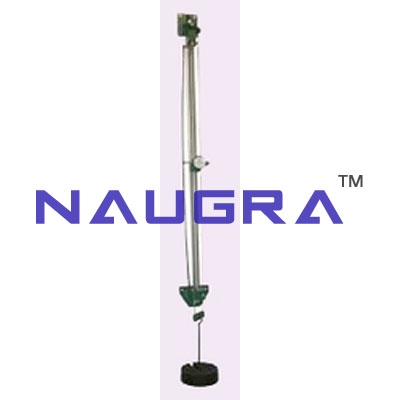- Civil Lab Mechanical Lab Engineering Lab Equipments
- sales@didacticlabequipments.com

CAT NO: DIDACTICNLE-Export-053013
Critical Load On Struts Apparatus- Engineering Lab Training Systems.
Features
Low cost effective teaching
Self-contained
Wall-mounted
Seven mild steel struts supplied
Extra strut available, eccentrically loaded
Tests pivoted or built-in ends
Longitudinal and lateral loading
Comparison with theoretical predictions
3 year warranty
Range of Experiments
Determination of Young's modulus of Elasticity for specimen material
Struts with pivoted ends, but varying lengths
a) to assess the effect of slenderness ratio on crippling load for the same specimen material
b) to compare with Euler and Perry-Robertson formula predictions
Struts of same length, but different end fixings
a) to assess the effect of end constraint on crippling load
b) to compare with Euler and Perry-Robertson formula predictions
c) to observe the shape of each critically loaded strut
Slender strut with eccentric loading (optional accessory)
a)
to investigate how the lateral deflection of an eccentrically loaded
strut varies with the applied load and eccentricity and to produce a
Southwell plot.
b) to compare the experimental and theoretical values for maximum lateral deflection
Description
This
equipment is part of a range designed to both demonstrate and
experimentally confirm basic engineering principles. Great care has been
given to each item so as to provide wide experimental scope without
unduly complicating or compromising the design. Each piece of apparatus
is self-contained and compact. Setting up time is minimal, all
measurements are made with the simplest possible instrumentation, so
that the student involvement is purely with the engineering principles
being taught.
A piece of material in compression is called a
strut. If it is short and stubby it will fail by compressive stress, but
if it is slender the failure mode is that of buckling. The load at
which the strut buckles depends on the way in which the ends are
restrained. Built-in ends resist buckling more than ends which are free
to move. The apparatus shows how the buckling mechanism occurs, and the
influence of the end restraint.
The apparatus is rigid and wall
mounted. It can test struts between 0.75 m and 1 m in length with either
pivoted or built-in ends. Axial load is applied to a load hanger linked
by cables to the yoked ram whose travel can be pre-set to prevent
permanent damage to the strut. A lateral load can be applied at any
position to the strut. Seven mild steel specimens are supplied as
standard. A dial gauge is supplied to measure strut deflection.
With
this equipment, an in depth study can be made of the factors that
effect the buckling of a strut; its length, cross section, material and
end restraint.
Young's modulus for the strut material is derived
in a secondary experiment, using the same equipment but with a specimen
loaded as a beam.
This equipment is part of a range designed to
both demonstrate and experimentally confirm basic engineering
principles. Great care has been given to each item so as to provide wide
experimental scope without unduly complicating or compromising the
design. Each piece of apparatus is self-contained and compact. Setting
up time is minimal, and all measurements are made with the simplest
possible instrumentation, so that the student involvement is purely with
the engineering principles being taught. A complete instruction manual
is provided describing the apparatus, its application, experimental
procedure and typical test results.
